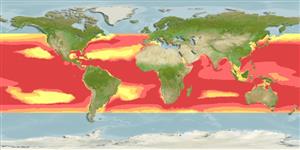Environment: milieu / climate zone / depth range / distribution range
Sinh thái học
Biển; Ở đại duơng, biển (Ref. 51243); Mức độ sâu 0 - 1000 m (Ref. 43). Subtropical; 22°C - 31°C (Ref. 43); 50°N - 45°S, 180°W - 180°E (Ref. 43)
Atlantic Ocean: in tropical and temperate waters. We follow Nakamura 1985 (Ref. 43) in recognizing Makaira mazara and Makaira nigricans as two distinct species chiefly because of differences in the pattern of the lateral line system. Many scientists, however, do not recognize this character as specifically diagnostic and consider the latter species as a single pantropical species occurring in the Atlantic, Pacific and Indian oceans. Highly migratory species.
Length at first maturity / Bộ gần gũi / Khối lượng (Trọng lượng) / Age
Maturity: Lm ?, range 50 - ? cm
Max length : 500 cm TL con đực/không giới tính; (Ref. 11441); 500.0 cm TL (female); common length : 290 cm TL con đực/không giới tính; (Ref. 6659); Khối lượng cực đại được công bố: 636.0 kg (Ref. 40637); Khối lượng cực đại được công bố: 636.0 kg
Các tia vây lưng cứng (tổng cộng) : 0; Các vây lưng mềm (tổng cộng) : 45 - 50; Tia cứng vây hậu môn: 0; Tia mềm vây hậu môn: 19 - 23. Body blue-black above and silvery white below, with about 15 rows of pale cobalt-colored stripes; 1st dorsal fin plain blackish or dark blue, other fins brown black with a tinge of dark blue in some specimens; anal fin bases with a tinge of silvery white. Lateral line a network of interconnecting canals (Ref. 26938).
An oceanic species. Water color affects its occurrence, at least in the northern Gulf of Mexico, where the fish show preference for blue water. Rarely gathers in schools and usually found as scattered single individuals. Feeds mainly on fishes but also preys on octopods and squids. Marketed fresh or frozen (Ref. 43). Feeding takes place during daytime. Maturity reached at about 80 cm in males and 50 cm in females (Ref. 36731). Females grow larger (Ref. 4770). Recent study indicates maximum age close to 20 years using a series of deductions in the ¹⁴C dating method (Ref. 120707).
Subripe ova are opaque, white to yellow, and 0.3 to 0.5 mm in diameter. Transparent spherical eggs flowing out of a ripe ovary measured 1 mm in diameter.
Nakamura, I., 1985. FAO species catalogue. Vol. 5. Billfishes of the world. An annotated and illustrated catalogue of marlins, sailfishes, spearfishes and swordfishes known to date. FAO Fish. Synop. 125(5):65p. Rome: FAO. (Ref. 43)
IUCN Red List Status (Ref. 130435)
Threat to humans
Harmless
Human uses
Các nghề cá: Tính thương mại; cá để chơi: đúng
Các công cụ
Special reports
Download XML
Các nguồn internet
Estimates based on models
Preferred temperature (Ref.
123201): 11.5 - 27.3, mean 22.4 °C (based on 477 cells).
Phylogenetic diversity index (Ref.
82804): PD
50 = 0.7505 [Uniqueness, from 0.5 = low to 2.0 = high].
Bayesian length-weight: a=0.00427 (0.00256 - 0.00710), b=3.11 (2.96 - 3.26), in cm total length, based on LWR estimates for this species & (Sub)family-body (Ref.
93245).
Mức dinh dưỡng (Ref.
69278): 4.5 ±0.3 se; based on diet studies.
Generation time: 3.4 ( na - na) years. Estimated as median ln(3)/K based on 1
growth studies.
Thích nghi nhanh (Ref.
120179): Trung bình, thời gian nhân đôi của chủng quần tối thiểu là 1.4 - 4.4 năm (K=0.1-0.3).
Prior r = 0.44, 95% CL = 0.29 - 0.66, Based on 6 full stock assessments.
Fishing Vulnerability (Ref.
59153): Moderate to high vulnerability (52 of 100).
Climate Vulnerability (Ref.
125649): Moderate to high vulnerability (50 of 100).
Nutrients (Ref.
124155): Calcium = 23.3 [9.7, 43.0] mg/100g; Iron = 0.898 [0.478, 1.711] mg/100g; Protein = 19.8 [18.5, 21.0] %; Omega3 = 0.245 [0.123, 0.499] g/100g; Selenium = 71.6 [34.5, 159.4] μg/100g; VitaminA = 3.61 [0.99, 13.41] μg/100g; Zinc = 0.283 [0.180, 0.446] mg/100g (wet weight);
